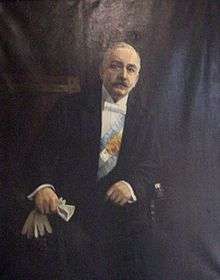1910 Argentine presidential election
The Argentine presidential election of 1910 was held on 13 March to choose the president of Argentina. Roque Sáenz Peña was elected president.
| ||||||||||||||||||||||||||
300 members of the Electoral College 151 votes needed to win | ||||||||||||||||||||||||||
|---|---|---|---|---|---|---|---|---|---|---|---|---|---|---|---|---|---|---|---|---|---|---|---|---|---|---|
| ||||||||||||||||||||||||||
| ||||||||||||||||||||||||||
Background
The ailing President Quintana's death in 1906 was the beginning of the end of Roca's dominance of national politics and policy. Moderate opposition to the PAN had greatly eroded its majorities in Congress, the very day the president died, and within months, Bartolomé Mitre and Carlos Pellegrini were dead, as well. President José Figueroa Alcorta defied Roca by signing many of Congressman Palacios' labor law reform bills and by 1909, Figueroa Alcorta was poised to nominate the reformist who had been turned away in 1892: Roque Sáenz Peña.[1]
Other prominent conservatives, such as La Nación publisher Emilio Mitre and Buenos Aires Governor Marcelino Ugarte, presented token candidacies. Sáenz Peña, who was the Ambassador to Italy and did not campaign, was selected unanimously on April 12, 1910. He promptly began negotiations with UCR leader Hipólito Yrigoyen for the introduction of legislation providing for universal male suffrage and the secret ballot. The president struggled over the bill with a still-conservative Congress, and on 10 February 1912, the Senate narrowly passed Law 8871. Providing for free and fair elections, as well as for the country's first uniform system of voter registration, the Sáenz Peña Law brought the prolonged "vote song" to an end.[2]
Results
| Argentine Republic | |
|---|---|
| Population | 7,092,000 |
| Voters | 199,000 |
| Turnout | 2.8% |
| Presidential Candidates | Party | Electoral Votes |
|---|---|---|
| Roque Sáenz Peña | National Autonomist Party | 265[lower-alpha 1] |
| Adolfo Contte | Liberal Party of Corrientes | 1 |
| Total voters | 266 | |
| Did not vote | 34 | |
| Total | 300 | |
| Vice Presidential Candidates | Party | Electoral Votes |
|---|---|---|
| Victorino de la Plaza | National Autonomist Party | 262[lower-alpha 2] |
| Indalecio Gómez | — | 2 |
| Manuel María de Iriondo | Radical Civic Union | 1 |
| Valentín Virasoro | Liberal Party of Corrientes | 1 |
| Total voters | 266 | |
| Did not vote | 34 | |
| Total | 300 | |
Results by Province
| Province | President | Vice President | |||||
|---|---|---|---|---|---|---|---|
| Sáenz Peña | Contte | de la Plaza | Gómez | de Iriondo | Virasoro | ||
| Buenos Aires City | 41 | 41 | |||||
| Buenos Aires | 49 | 49 | |||||
| Catamarca | 9 | 9 | |||||
| Córdoba | 24 | 21 | 2 | 1 | |||
| Corrientes | 16 | 1 | 16 | 1 | |||
| Entre Ríos | 19 | 19 | |||||
| Jujuy | 6 | 6 | |||||
| La Rioja | 7 | 7 | |||||
| Mendoza | 12 | 12 | |||||
| Salta | 12 | 12 | |||||
| San Juan | 10 | 10 | |||||
| San Luis | 10 | 10 | |||||
| Santa Fe | 25 | 25 | |||||
| Santiago del Estero | 9 | 9 | |||||
| Tucumán | 16 | 16 | |||||
| Total | 265[lower-alpha 1] | 1 | 262[lower-alpha 2] | 2 | 1 | 1 | |
Notes
- Todo Argentina: 1910 (in Spanish)
- Todo Argentina: 1912 (in Spanish)
- Although only 265 electors voted for Roque Sáenz Peña, in the final count he appears with 264 votes.
- Although only 262 electors voted for Victorino de la Plaza, in the final count he appears with 259 votes.
References
- Diario de sesiones de la Cámara de Senadores - Año 1910 - Tomo I. Buenos Aires: Establecimiento Tipográfico "El Comercio". 1910. pp. 336–354.
- Duhalde, Eduardo Luis (2007). Acción Parlamentaria de John William Cooke. Buenos Aires: Colihue. p. 232. ISBN 978-950-563-460-6.
- "Historia Electoral Argentina (1912-2007), p. 58" (PDF). www.mininterior.gov.ar. Ministry of the Interior. December 2008. Retrieved 13 June 2017.

